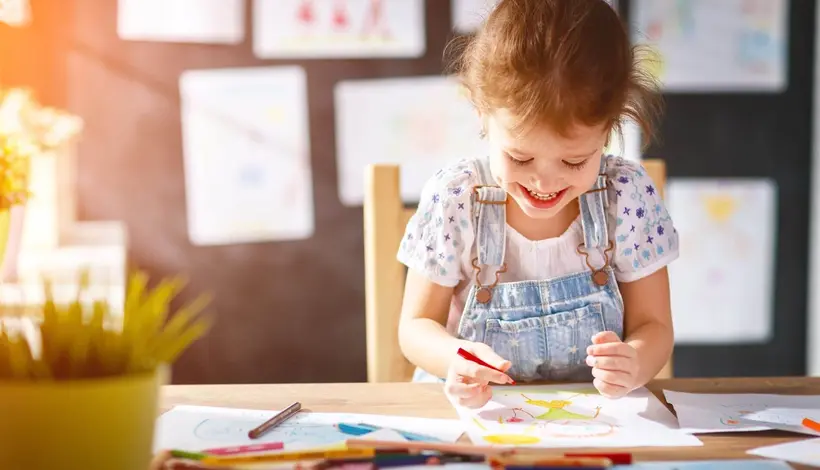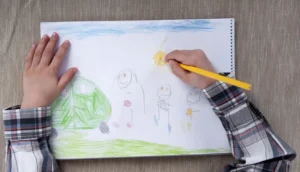The Power of Children’s Drawings: Unlocking Insights into a Child’s Mind

Children’s drawings, often referred to as “childhood sketches” by adults, are far more than a simple pastime. They are a window into a child’s inner world, revealing their thoughts, emotions, imagination, and unique perspective on life. At OnSeminars, we recognize the profound value of children’s artwork, which is why we’ve developed our Understanding Children’s Drawings: Analysis and Insights seminar to help parents, educators, and professionals explore this powerful tool. In this article, we’ll delve into the significance of children’s drawings and how they can be used to support a child’s emotional and developmental growth.
A Window into a Child’s Inner World
When a child picks up a crayon to draw, they’re not just keeping busy—they’re telling a story. Children’s drawings are a rich narrative of how they see the world, process their emotions, and express their creativity. Through shapes, colours, and symbols, a child captures their experiences, from their role within the family to their interactions at school and in their community. These drawings often reveal hidden emotions—such as fears, desires, anger, or shame—that a child may not feel able to express verbally. By studying these artworks, parents and professionals can gain deep insights into a child’s emotional state and developmental progress.
Understanding Development Through Drawings
Children’s drawings offer a unique lens to observe a child’s developmental journey. From the first scribbles of a toddler to the more detailed sketches of an older child, each stage of drawing reflects a child’s growth in motor skills, cognitive abilities, and emotional expression. For instance, early scribbles can indicate a child’s initial steps towards autonomy, while later drawings might reveal their social connections, self-perception, and even their dreams. Educators and child psychologists can use these drawings to identify whether a child is transitioning smoothly through developmental stages or facing challenges, such as difficulties in building trust, forming relationships, or engaging with the world around them.
A Historical Perspective: The Evolution of Drawing Analysis
The importance of children’s drawings wasn’t always recognized. In the late 19th century, art teacher Ebenezer Cooke[1] (1837–1913) published an article titled Our Art Teaching and Child Nature, highlighting the potential of children’s drawings to unlock insights into their psyche. At the time, most parents, educators, and mental health professionals viewed drawing as a mere childhood activity with little significance. However, Cooke’s work marked a turning point, paving the way for modern child psychology to embrace drawings as a valuable tool for understanding children’s emotional and developmental needs.
Understanding Children’s Drawings: Analysis and Insights
🏷️ Only £70 per month
⏱️ Duration: 2 hours per week for 10 months
👨🏫 Taught by human instructor
💻 Remote Live learning
📖 Free study notes and resources
🎓 Option to receive a certificate of completion
Drawings as a Tool for Emotional Expression
Unlike verbal communication or physical movements, children’s drawings provide a subtle yet powerful form of non-verbal expression. For young children who may not yet have the language skills to articulate their feelings, or for those who feel too scared or restricted to speak openly, drawing offers a safe outlet. A child’s artwork can reveal their optimistic or pessimistic outlook, their ability to connect with others, or even signs of withdrawal and isolation. By analyzing the details—such as the size of figures, the choice of colours, and the placement of elements on the page—educators and psychologists can uncover the child’s lived reality and emotional experiences.
Supporting Learning and Identifying Challenges
Children’s drawings are not only a reflection of their emotions but also a key indicator of their learning journey. By observing a child’s graphomotor development—from their first scribbles to their ability to form letters—educators can assess their readiness for writing and identify potential learning difficulties. Drawings can also highlight how a child processes information and engages with their environment, offering clues about their preferred learning styles. This makes children’s drawings an essential tool for tailoring educational support to a child’s unique needs.
A Psychometric Tool: Detecting Trauma and Supporting Healing
For children who may have experienced trauma, such as family conflicts, school-related issues, or any form of abuse, drawings can serve as a reliable psychometric tool. When a child draws, they feel free to express what they might otherwise suppress due to fear or a lack of verbal skills. This makes drawings particularly valuable for identifying signs of emotional distress or abuse. At OnSeminars, our Understanding Children’s Drawings: Analysis and Insights seminar teaches participants how to decode these signs, enabling early interventions that can mitigate the impact of trauma and foster a child’s emotional resilience.
The Role of Art Therapy in Child Development
Art therapy, which includes the use of children’s drawings, has emerged as a promising therapeutic method for supporting children with emotional challenges, learning difficulties, or adjustment issues. First recognized for its therapeutic potential in the 1940s, art therapy became an established practice in the UK and the US by the 1960s, with Greece adopting it in the 1980s. Today, in 2025, art therapy continues to evolve, offering a creative outlet for children to express their inner world freely. Through drawing, sculpting with clay, or engaging in other crafts, children can project their emotions in a safe, unfiltered way, allowing therapists and educators to support their healing and growth.
Why Children’s Drawings Matter: A Call to Action
Children’s drawings are a powerful map to their psyche, offering insights that a child might not be able to articulate due to age, fear, or other barriers. By studying these drawings, educators, parents, and mental health professionals can better understand a child’s personality, address their fears and traumas, and nurture their creativity and emotional potential. This understanding enables timely interventions that can reduce obstacles to a child’s expression and development, paving the way for a healthier, more confident future.
Why Children’s Drawings Matter: A Call to Action
Children’s drawings are a powerful map to their psyche, offering insights that a child might not be able to articulate due to age, fear, or other barriers. By studying these drawings, educators, parents, and mental health professionals can better understand a child’s personality, address their fears and traumas, and nurture their creativity and emotional potential. This understanding enables timely interventions that can reduce obstacles to a child’s expression and development, paving the way for a healthier, more confident future.
Explore More with OnSeminars
At OnSeminars, we’re passionate about helping you unlock the hidden meanings in children’s drawings to support their growth and well-being. Our Understanding Children’s Drawings: Analysis and Insights seminar provides in-depth training on how to analyze children’s artwork, from identifying developmental milestones to using art therapy for healing. Join our live online seminars today to gain the skills you need to make a difference in a child’s life. Visit our Live Seminars page to find the perfect program for you and start your learning journey with OnSeminars!

